Clinical Reasoning Report: Assessment of Jessie's Health Case Study
VerifiedAdded on 2023/01/11
|7
|1245
|78
Report
AI Summary
This report analyzes a clinical case study involving a patient named Jessie, who presents with elevated body temperature, rapid pulse, and increased respiratory rate. The report examines both objective and subjective data, interpreting the assessment findings to identify potential health risks such as hypertension and respiratory issues. It highlights the importance of gathering further cues, including the patient's medical and family history, and communicating with family members to gain a comprehensive understanding of the patient's condition. The analysis emphasizes the need for healthcare professionals to continuously monitor the patient, assess for any previous symptoms, and provide holistic care by building rapport with the patient and utilizing effective communication. The report also references relevant literature to support the clinical reasoning process, underscoring the importance of a thorough and systematic approach to patient assessment and care.
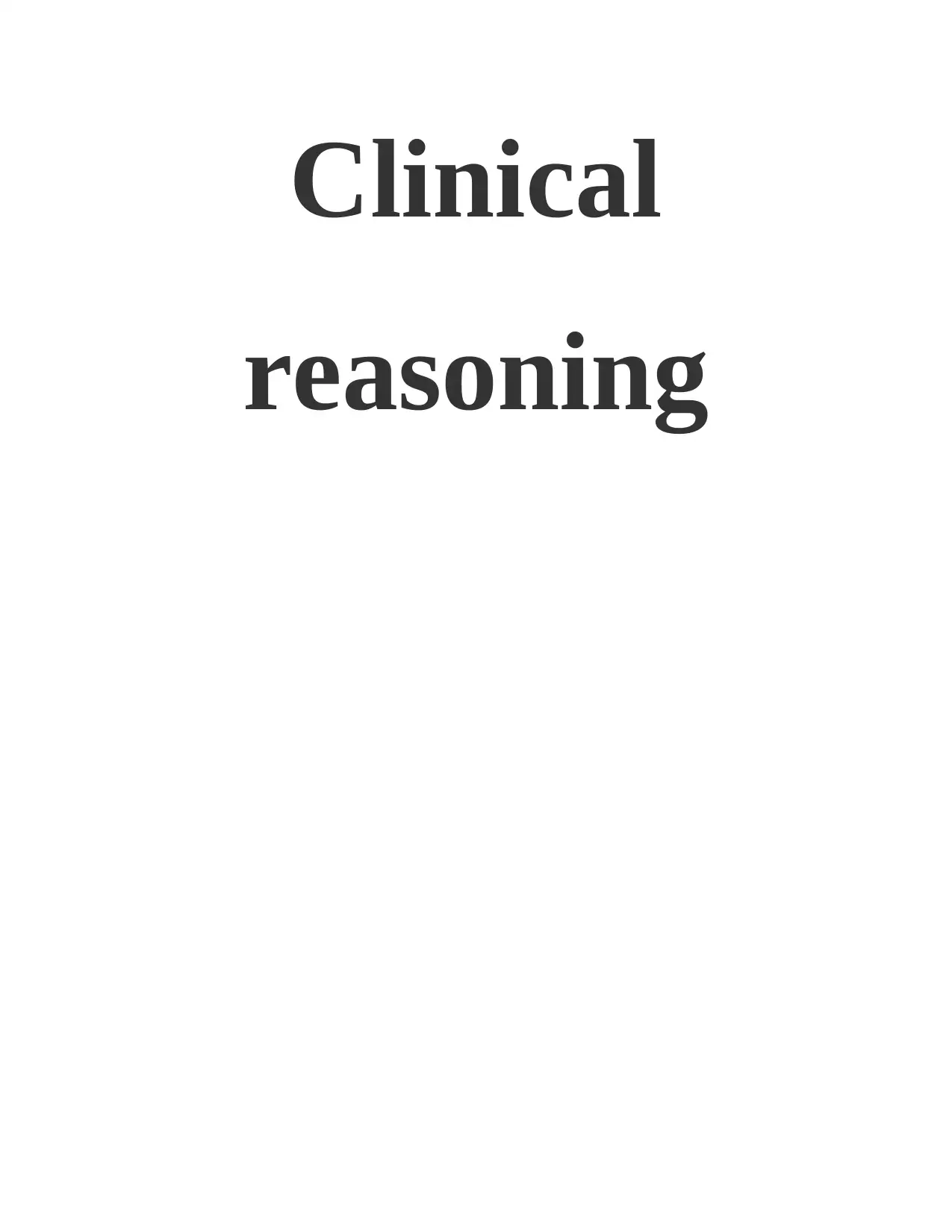
Clinical
reasoning
reasoning
Paraphrase This Document
Need a fresh take? Get an instant paraphrase of this document with our AI Paraphraser
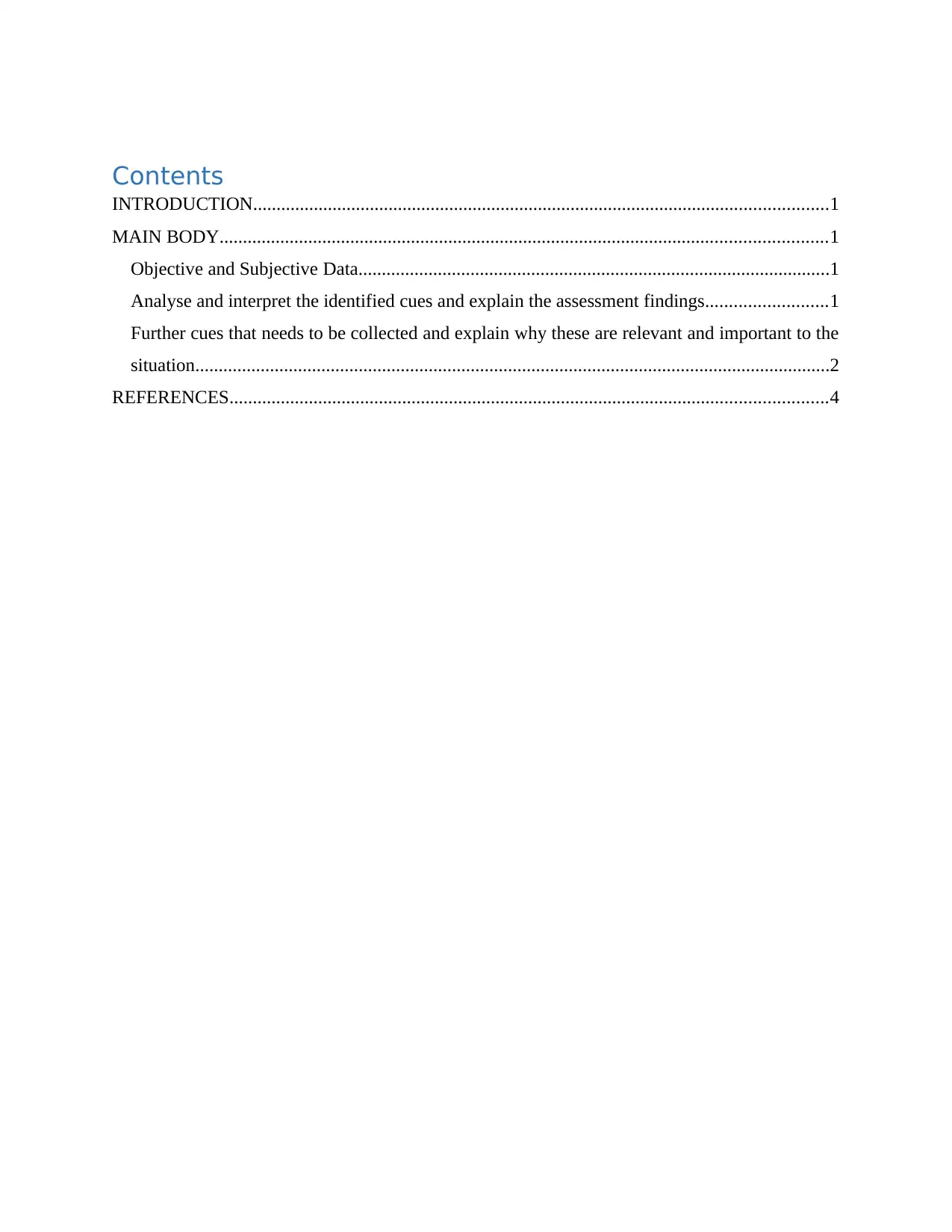
Contents
INTRODUCTION...........................................................................................................................1
MAIN BODY..................................................................................................................................1
Objective and Subjective Data.....................................................................................................1
Analyse and interpret the identified cues and explain the assessment findings..........................1
Further cues that needs to be collected and explain why these are relevant and important to the
situation........................................................................................................................................2
REFERENCES................................................................................................................................4
INTRODUCTION...........................................................................................................................1
MAIN BODY..................................................................................................................................1
Objective and Subjective Data.....................................................................................................1
Analyse and interpret the identified cues and explain the assessment findings..........................1
Further cues that needs to be collected and explain why these are relevant and important to the
situation........................................................................................................................................2
REFERENCES................................................................................................................................4
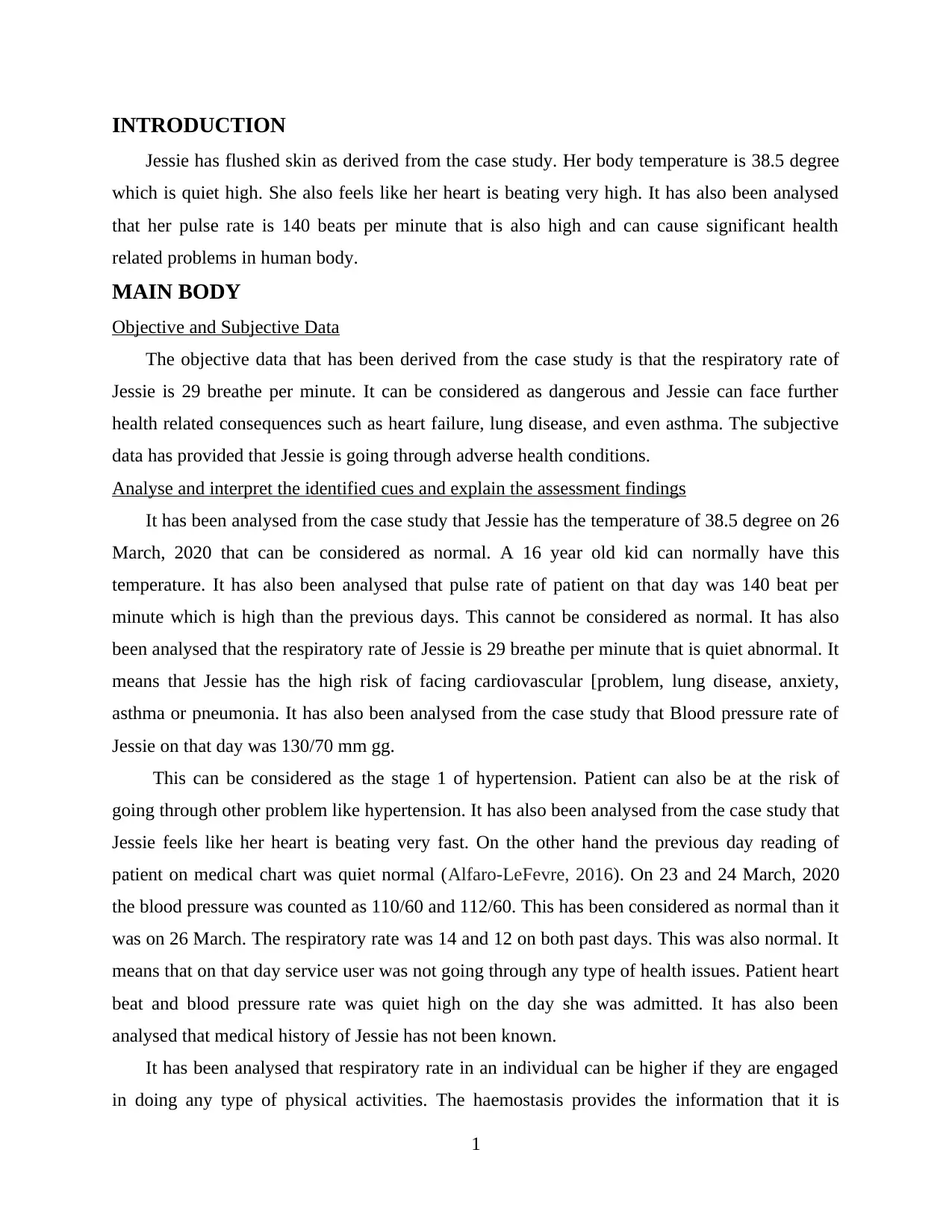
INTRODUCTION
Jessie has flushed skin as derived from the case study. Her body temperature is 38.5 degree
which is quiet high. She also feels like her heart is beating very high. It has also been analysed
that her pulse rate is 140 beats per minute that is also high and can cause significant health
related problems in human body.
MAIN BODY
Objective and Subjective Data
The objective data that has been derived from the case study is that the respiratory rate of
Jessie is 29 breathe per minute. It can be considered as dangerous and Jessie can face further
health related consequences such as heart failure, lung disease, and even asthma. The subjective
data has provided that Jessie is going through adverse health conditions.
Analyse and interpret the identified cues and explain the assessment findings
It has been analysed from the case study that Jessie has the temperature of 38.5 degree on 26
March, 2020 that can be considered as normal. A 16 year old kid can normally have this
temperature. It has also been analysed that pulse rate of patient on that day was 140 beat per
minute which is high than the previous days. This cannot be considered as normal. It has also
been analysed that the respiratory rate of Jessie is 29 breathe per minute that is quiet abnormal. It
means that Jessie has the high risk of facing cardiovascular [problem, lung disease, anxiety,
asthma or pneumonia. It has also been analysed from the case study that Blood pressure rate of
Jessie on that day was 130/70 mm gg.
This can be considered as the stage 1 of hypertension. Patient can also be at the risk of
going through other problem like hypertension. It has also been analysed from the case study that
Jessie feels like her heart is beating very fast. On the other hand the previous day reading of
patient on medical chart was quiet normal (Alfaro-LeFevre, 2016). On 23 and 24 March, 2020
the blood pressure was counted as 110/60 and 112/60. This has been considered as normal than it
was on 26 March. The respiratory rate was 14 and 12 on both past days. This was also normal. It
means that on that day service user was not going through any type of health issues. Patient heart
beat and blood pressure rate was quiet high on the day she was admitted. It has also been
analysed that medical history of Jessie has not been known.
It has been analysed that respiratory rate in an individual can be higher if they are engaged
in doing any type of physical activities. The haemostasis provides the information that it is
1
Jessie has flushed skin as derived from the case study. Her body temperature is 38.5 degree
which is quiet high. She also feels like her heart is beating very high. It has also been analysed
that her pulse rate is 140 beats per minute that is also high and can cause significant health
related problems in human body.
MAIN BODY
Objective and Subjective Data
The objective data that has been derived from the case study is that the respiratory rate of
Jessie is 29 breathe per minute. It can be considered as dangerous and Jessie can face further
health related consequences such as heart failure, lung disease, and even asthma. The subjective
data has provided that Jessie is going through adverse health conditions.
Analyse and interpret the identified cues and explain the assessment findings
It has been analysed from the case study that Jessie has the temperature of 38.5 degree on 26
March, 2020 that can be considered as normal. A 16 year old kid can normally have this
temperature. It has also been analysed that pulse rate of patient on that day was 140 beat per
minute which is high than the previous days. This cannot be considered as normal. It has also
been analysed that the respiratory rate of Jessie is 29 breathe per minute that is quiet abnormal. It
means that Jessie has the high risk of facing cardiovascular [problem, lung disease, anxiety,
asthma or pneumonia. It has also been analysed from the case study that Blood pressure rate of
Jessie on that day was 130/70 mm gg.
This can be considered as the stage 1 of hypertension. Patient can also be at the risk of
going through other problem like hypertension. It has also been analysed from the case study that
Jessie feels like her heart is beating very fast. On the other hand the previous day reading of
patient on medical chart was quiet normal (Alfaro-LeFevre, 2016). On 23 and 24 March, 2020
the blood pressure was counted as 110/60 and 112/60. This has been considered as normal than it
was on 26 March. The respiratory rate was 14 and 12 on both past days. This was also normal. It
means that on that day service user was not going through any type of health issues. Patient heart
beat and blood pressure rate was quiet high on the day she was admitted. It has also been
analysed that medical history of Jessie has not been known.
It has been analysed that respiratory rate in an individual can be higher if they are engaged
in doing any type of physical activities. The haemostasis provides the information that it is
1
⊘ This is a preview!⊘
Do you want full access?
Subscribe today to unlock all pages.

Trusted by 1+ million students worldwide
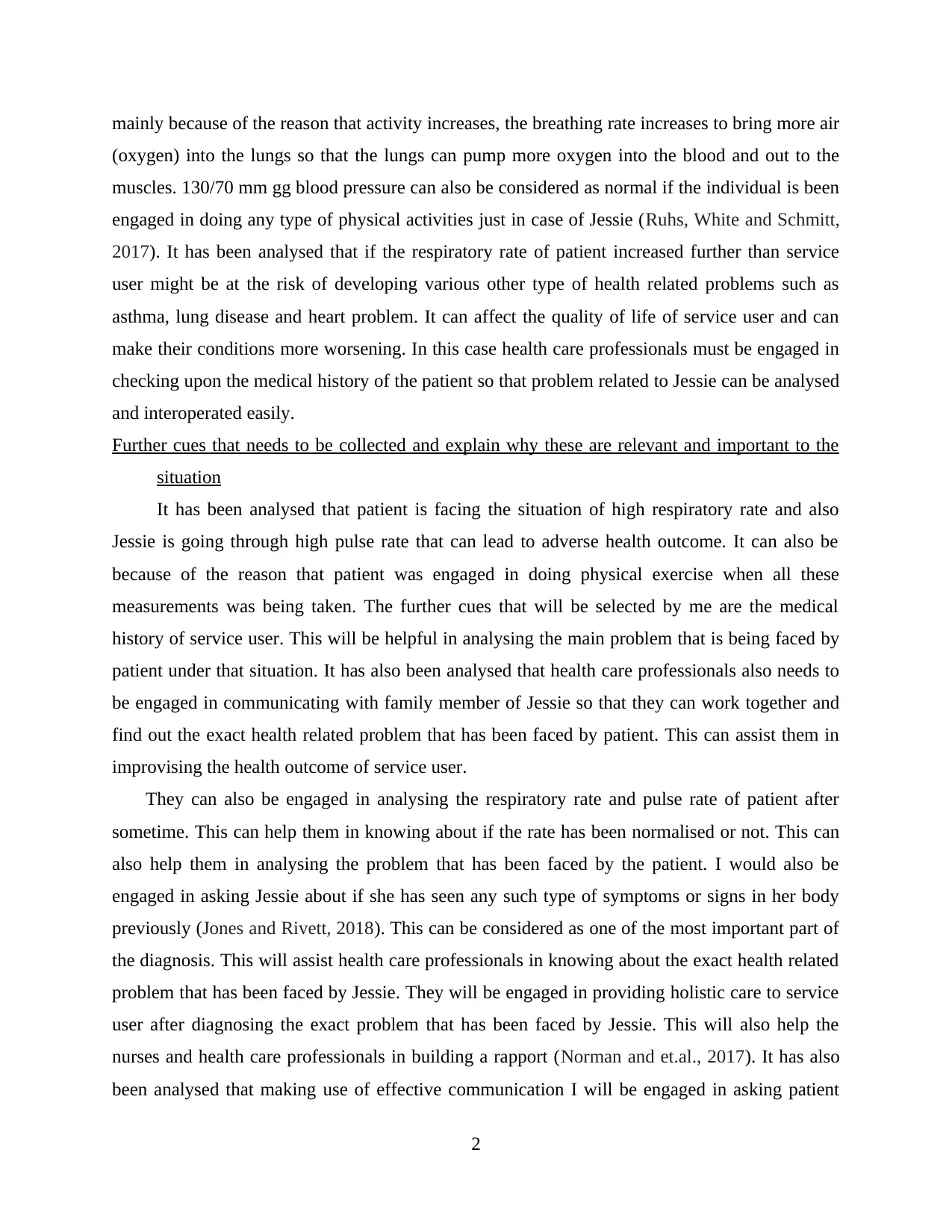
mainly because of the reason that activity increases, the breathing rate increases to bring more air
(oxygen) into the lungs so that the lungs can pump more oxygen into the blood and out to the
muscles. 130/70 mm gg blood pressure can also be considered as normal if the individual is been
engaged in doing any type of physical activities just in case of Jessie (Ruhs, White and Schmitt,
2017). It has been analysed that if the respiratory rate of patient increased further than service
user might be at the risk of developing various other type of health related problems such as
asthma, lung disease and heart problem. It can affect the quality of life of service user and can
make their conditions more worsening. In this case health care professionals must be engaged in
checking upon the medical history of the patient so that problem related to Jessie can be analysed
and interoperated easily.
Further cues that needs to be collected and explain why these are relevant and important to the
situation
It has been analysed that patient is facing the situation of high respiratory rate and also
Jessie is going through high pulse rate that can lead to adverse health outcome. It can also be
because of the reason that patient was engaged in doing physical exercise when all these
measurements was being taken. The further cues that will be selected by me are the medical
history of service user. This will be helpful in analysing the main problem that is being faced by
patient under that situation. It has also been analysed that health care professionals also needs to
be engaged in communicating with family member of Jessie so that they can work together and
find out the exact health related problem that has been faced by patient. This can assist them in
improvising the health outcome of service user.
They can also be engaged in analysing the respiratory rate and pulse rate of patient after
sometime. This can help them in knowing about if the rate has been normalised or not. This can
also help them in analysing the problem that has been faced by the patient. I would also be
engaged in asking Jessie about if she has seen any such type of symptoms or signs in her body
previously (Jones and Rivett, 2018). This can be considered as one of the most important part of
the diagnosis. This will assist health care professionals in knowing about the exact health related
problem that has been faced by Jessie. They will be engaged in providing holistic care to service
user after diagnosing the exact problem that has been faced by Jessie. This will also help the
nurses and health care professionals in building a rapport (Norman and et.al., 2017). It has also
been analysed that making use of effective communication I will be engaged in asking patient
2
(oxygen) into the lungs so that the lungs can pump more oxygen into the blood and out to the
muscles. 130/70 mm gg blood pressure can also be considered as normal if the individual is been
engaged in doing any type of physical activities just in case of Jessie (Ruhs, White and Schmitt,
2017). It has been analysed that if the respiratory rate of patient increased further than service
user might be at the risk of developing various other type of health related problems such as
asthma, lung disease and heart problem. It can affect the quality of life of service user and can
make their conditions more worsening. In this case health care professionals must be engaged in
checking upon the medical history of the patient so that problem related to Jessie can be analysed
and interoperated easily.
Further cues that needs to be collected and explain why these are relevant and important to the
situation
It has been analysed that patient is facing the situation of high respiratory rate and also
Jessie is going through high pulse rate that can lead to adverse health outcome. It can also be
because of the reason that patient was engaged in doing physical exercise when all these
measurements was being taken. The further cues that will be selected by me are the medical
history of service user. This will be helpful in analysing the main problem that is being faced by
patient under that situation. It has also been analysed that health care professionals also needs to
be engaged in communicating with family member of Jessie so that they can work together and
find out the exact health related problem that has been faced by patient. This can assist them in
improvising the health outcome of service user.
They can also be engaged in analysing the respiratory rate and pulse rate of patient after
sometime. This can help them in knowing about if the rate has been normalised or not. This can
also help them in analysing the problem that has been faced by the patient. I would also be
engaged in asking Jessie about if she has seen any such type of symptoms or signs in her body
previously (Jones and Rivett, 2018). This can be considered as one of the most important part of
the diagnosis. This will assist health care professionals in knowing about the exact health related
problem that has been faced by Jessie. They will be engaged in providing holistic care to service
user after diagnosing the exact problem that has been faced by Jessie. This will also help the
nurses and health care professionals in building a rapport (Norman and et.al., 2017). It has also
been analysed that making use of effective communication I will be engaged in asking patient
2
Paraphrase This Document
Need a fresh take? Get an instant paraphrase of this document with our AI Paraphraser
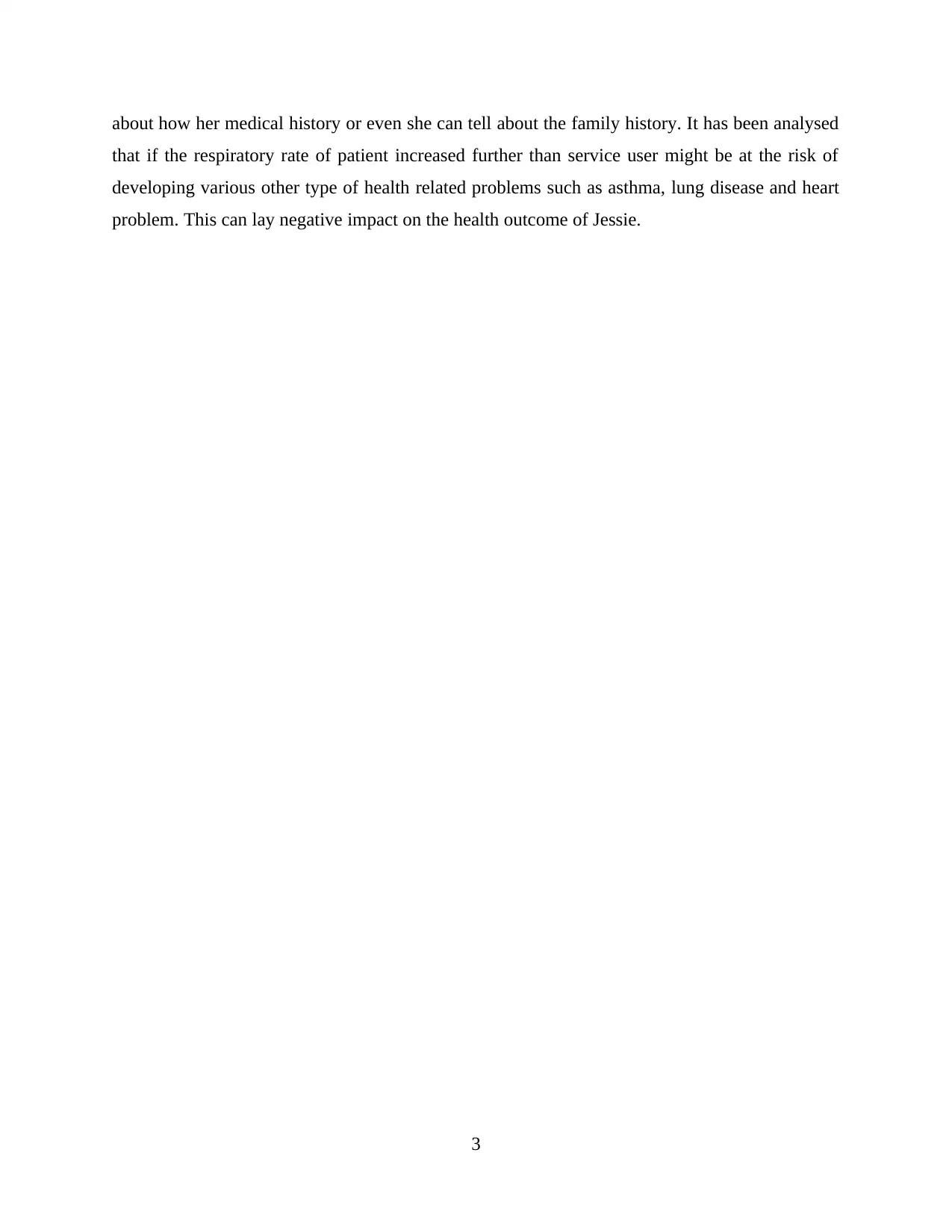
about how her medical history or even she can tell about the family history. It has been analysed
that if the respiratory rate of patient increased further than service user might be at the risk of
developing various other type of health related problems such as asthma, lung disease and heart
problem. This can lay negative impact on the health outcome of Jessie.
3
that if the respiratory rate of patient increased further than service user might be at the risk of
developing various other type of health related problems such as asthma, lung disease and heart
problem. This can lay negative impact on the health outcome of Jessie.
3
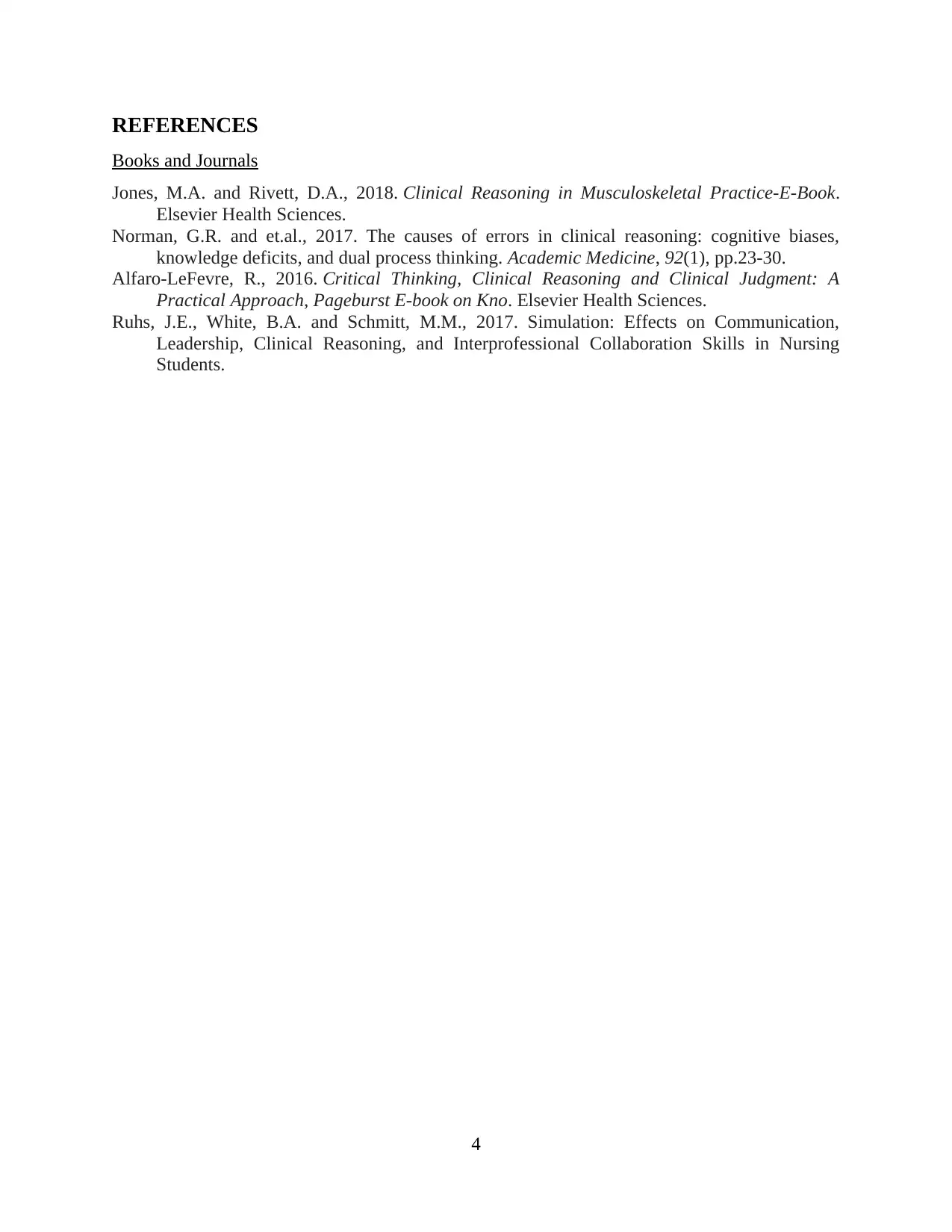
REFERENCES
Books and Journals
Jones, M.A. and Rivett, D.A., 2018. Clinical Reasoning in Musculoskeletal Practice-E-Book.
Elsevier Health Sciences.
Norman, G.R. and et.al., 2017. The causes of errors in clinical reasoning: cognitive biases,
knowledge deficits, and dual process thinking. Academic Medicine, 92(1), pp.23-30.
Alfaro-LeFevre, R., 2016. Critical Thinking, Clinical Reasoning and Clinical Judgment: A
Practical Approach, Pageburst E-book on Kno. Elsevier Health Sciences.
Ruhs, J.E., White, B.A. and Schmitt, M.M., 2017. Simulation: Effects on Communication,
Leadership, Clinical Reasoning, and Interprofessional Collaboration Skills in Nursing
Students.
4
Books and Journals
Jones, M.A. and Rivett, D.A., 2018. Clinical Reasoning in Musculoskeletal Practice-E-Book.
Elsevier Health Sciences.
Norman, G.R. and et.al., 2017. The causes of errors in clinical reasoning: cognitive biases,
knowledge deficits, and dual process thinking. Academic Medicine, 92(1), pp.23-30.
Alfaro-LeFevre, R., 2016. Critical Thinking, Clinical Reasoning and Clinical Judgment: A
Practical Approach, Pageburst E-book on Kno. Elsevier Health Sciences.
Ruhs, J.E., White, B.A. and Schmitt, M.M., 2017. Simulation: Effects on Communication,
Leadership, Clinical Reasoning, and Interprofessional Collaboration Skills in Nursing
Students.
4
⊘ This is a preview!⊘
Do you want full access?
Subscribe today to unlock all pages.

Trusted by 1+ million students worldwide

5
1 out of 7
Related Documents
Your All-in-One AI-Powered Toolkit for Academic Success.
+13062052269
info@desklib.com
Available 24*7 on WhatsApp / Email
![[object Object]](/_next/static/media/star-bottom.7253800d.svg)
Unlock your academic potential
Copyright © 2020–2025 A2Z Services. All Rights Reserved. Developed and managed by ZUCOL.





